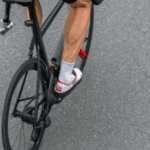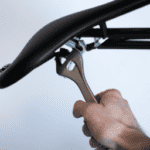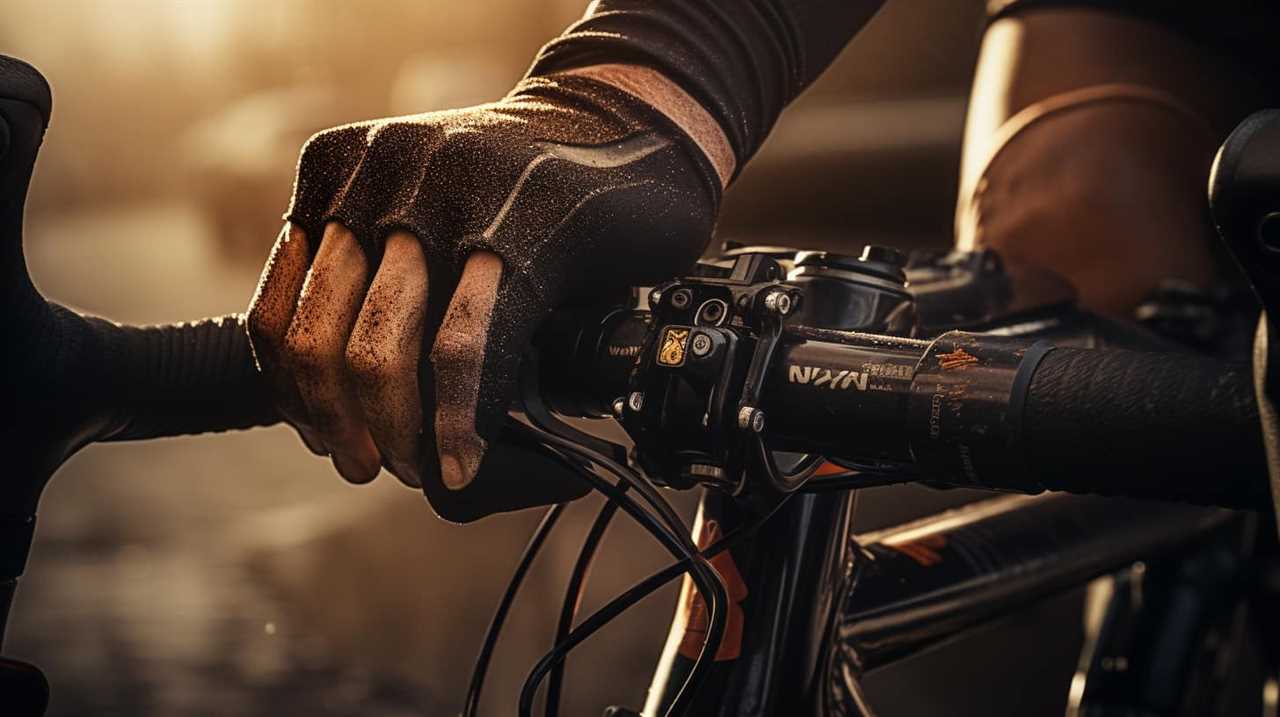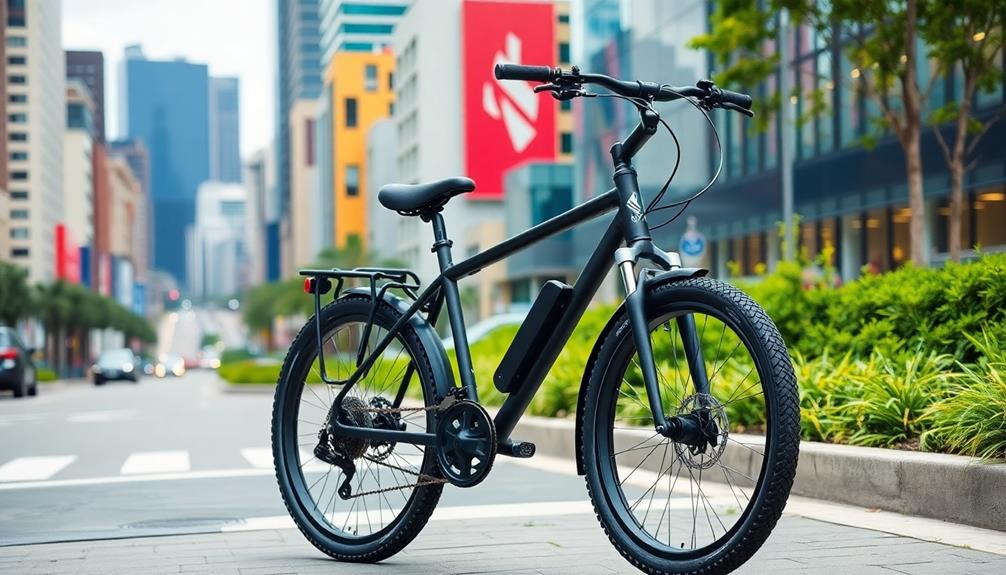When riding a hybrid bike, avoid common posture mistakes that can cause discomfort and efficiency issues. Make certain your handlebars are level with or slightly higher than your saddle to prevent neck and back pain. Adjust your saddle height so there's a slight bend in your knee at the lowest pedal point; this will enhance comfort and power transfer. Maintain a neutral spine by not leaning too far forward, and guarantee your elbows have a slight bend when gripping the handlebars. By tuning into these adjustments, you'll ride more comfortably and effectively, and there's more to explore about bike fitting for peak performance.
Key Takeaways
- Ensure handlebars are level with or slightly above saddle height to prevent neck and lower back pain.
- Maintain a slight elbow bend and neutral spine to avoid shoulder strain while riding.
- Adjust saddle height so that your knee has a slight bend at the lowest pedal point to prevent knee pain.
- Check stem length for a comfortable reach, ensuring elbows are slightly bent to reduce upper body strain.
- Regularly assess bike fit and posture adjustments to enhance comfort and prevent long-term health issues.
Importance of Proper Posture
Proper posture on a hybrid bike is vital for any rider looking to enhance their experience. When you maintain proper posture, you not only improve your comfort but also allow for more efficient power transfer, which can reduce fatigue during longer rides.
An upright riding position, typical of hybrid bikes, helps you achieve better visibility and control, making urban commuting much safer. Additionally, guaranteeing your riding environment is safe and free from hazards can further enhance your riding experience, similar to the importance of following wood stove safety standards.
To establish proper posture, focus on your bike fitting. Start by adjusting your saddle height. If your saddle is too low or too high, you might lean too far forward or slouch, leading to discomfort or pain over time.
Maintaining a neutral spine position is essential—it prevents strain on your back and neck, keeping you comfortable throughout your ride.
Regular adjustments to your handlebar height can also greatly enhance your riding position. You want to feel relaxed and not overreach or hunch your shoulders.
Common Posture Errors

Many riders unknowingly make common posture errors that can lead to discomfort and reduced performance on a hybrid bike.
These issues can be exacerbated by a lack of proper understanding of common financial terms related to investments in biking equipment.
Here are some key mistakes to watch for:
- Handlebars Too Low: If your handlebars are below saddle height, you may experience neck and lower back pain. Adjust them to be level with or above the saddle for a more upright position.
- Leaning Too Far Forward: This often leads to shoulder strain. Keep a neutral spine with a slight bend in your elbows to distribute weight evenly and reduce discomfort.
- Incorrect Saddle Height: If your saddle is too low or high, it can strain your knees. Aim for a slight knee bend when the pedal is at its lowest point to guarantee proper leg extension.
- Neglecting Stem Length: An improper stem length can affect your reach, causing strain on your upper body. Adjust the stem so that your elbows maintain a comfortable bend, enhancing overall riding efficiency.
Effects of Poor Posture
Poor posture on your hybrid bike can lead to discomfort and pain, especially in your back and neck.
This discomfort may be exacerbated by the physical demands of cycling, as well as the key domains of development in psychology that highlight the importance of environmental interactions in physical activities.
Not only does this affect your immediate riding experience, but it can also reduce your efficiency and lead to long-term health issues.
Addressing these posture problems is essential for enjoying your rides and staying injury-free.
Discomfort and Pain
When you ride a hybrid bike with improper posture, you can quickly find yourself facing discomfort and pain. Poor alignment can lead to significant issues, especially after riding long distances.
For instance, just like the importance of proper tick removal from pets, maintaining correct posture is vital for preventing long-term discomfort. Here are some common areas affected by bad posture:
- Lower Back Pain: Improper alignment may contribute to chronic back issues, causing discomfort that can linger long after your ride.
- Knee Pain: A misaligned saddle position can strain your knees, resulting in pain when pedaling and increasing your risk of injury.
- Neck and Shoulder Pain: Incorrect handlebar height can force you to overextend, leading to muscle fatigue and discomfort in these areas.
- Breathing Issues: A hunched posture compresses your diaphragm, which can affect your breathing efficiency and even lead to digestive problems.
These discomforts not only make your rides less enjoyable but can also discourage you from riding long distances.
It's important to address these posture mistakes to enhance your overall cycling experience and maintain your fitness. Prioritizing good posture will help you ride longer and enjoyably.
Reduced Efficiency
Even a slight misalignment in your riding posture can dramatically impact your efficiency on a hybrid bike. When your seat height isn't set correctly, it can cause your knees to misalign, leading to strain and a noticeable drop in pedaling efficiency. This misalignment may reduce your energy output by as much as 30% compared to an ideal riding position.
Additionally, confirming that your posture is correct can also contribute to a more eco-friendly lifestyle, as proper riding technique can lead to less energy wasted and a reduced carbon footprint while cycling lower carbon footprint.
If you find yourself leaning too far forward, it can restrict your breathing capacity, which ultimately limits your aerobic performance on longer rides. A neutral spine is essential; a hunched posture not only contributes to muscle fatigue but also affects your ability to sustain power output over time.
To maximize your efficiency, pay attention to your bike fit and confirm your riding posture is aligned properly. Adjusting your seat height is a simple yet effective way to enhance your overall cycling performance.
Take a moment to reassess your position on the bike; small adjustments can lead to significant improvements in your riding experience and efficiency. Remember, maintaining the right posture isn't just about comfort—it's about getting the most out of every ride.
Long-term Health Issues
Many cyclists overlook the impact of their riding posture, but improper alignment can lead to significant long-term health issues. When you're riding a hybrid bike, poor posture can result in chronic pain and discomfort that might affect your overall cycling experience.
Regularly evaluating your riding position is vital to prevent these issues, as essential skills for quality assurance software testers can also apply to maintaining proper cyclist posture. Here are some common issues you could face:
- Chronic Pain: Over 60% of cyclists report neck, shoulder, and lower back pain due to poor posture.
- Nerve Compression: Misalignment can cause numbness or tingling in your hands and feet, affecting up to 30% of cyclists.
- Repetitive Strain Injuries: Extended periods of incorrect posture can lead to tendonitis, particularly among those who ride frequently.
- Joint Discomfort: Inadequate saddle height or handlebar positioning can exacerbate hip and knee issues, with 40% reporting discomfort in these areas.
Ignoring these factors can lead to decreased endurance and power output, forcing you to shorten your rides.
Regularly checking your saddle height and overall alignment can help you avoid these long-term consequences and enjoy your rides more fully, whether you're on a mountain bike or a hybrid.
Adjusting Saddle Height

Finding the right saddle height is vital for a comfortable and efficient ride on your hybrid bike. Proper leg extension while pedaling helps prevent knee pain and enhances your overall cycling experience.
To adjust your saddle height, consider using the heel-on-pedal method. Place your heel on the pedal at its lowest point; your leg should fully extend without rocking your hips. This guarantees your saddle height is ideal for power transfer and comfort.
Here's a helpful table for determining your ideal saddle height:
| Method | Description |
|---|---|
| Heel-on-Pedal | Leg fully extended without hip rocking |
| 109% Method | Inseam length × 1.09 = Saddle height |
| Regular Assessment | Reassess after changes in fitness or weight |
| Signs of Incorrect Height | Knee pain, fatigue, or inefficient power transfer |
Regularly checking your saddle height is important, especially after significant changes in riding style or body weight. A well-adjusted saddle not only boosts your efficiency but also keeps you comfortable throughout your ride.
Correcting Handlebar Position

To ride comfortably on your hybrid bike, it's vital to get the handlebar height just right—ideally level with or slightly higher than your saddle.
Proper handlebar positioning can greatly enhance your riding experience and prevent strain, much like how optimal comfort is essential for heat pump efficiency.
You also need to make sure your reach allows for a slight bend in your elbows, which keeps your posture relaxed.
Adjusting these elements can help prevent discomfort and improve your overall riding experience.
Ideal Handlebar Height
Comfort is key when it comes to enjoying your ride on a hybrid bike, and the ideal handlebar height plays a significant role in achieving that.
It's essential to position your handlebars level with or slightly below your saddle height. This allows for a comfortable, upright riding position that reduces strain on your back and neck. Proper cold medications overview can also help maintain overall wellness during your rides, especially if you're cycling in cooler weather.
Here are some tips to help you find that sweet spot:
- Check Elbow Bend: Confirm there's a slight bend in your elbows when gripping the handlebars, promoting a relaxed posture.
- Maintain Neutral Spine: Your spine should remain neutral, so avoid setting the handlebars too low, which can cause discomfort.
- Assess Lower Back and Neck Comfort: If you experience soreness, it may indicate your handlebar height needs adjustment.
- Adjust Regularly: As your body or riding preferences change, revisit your handlebar height to maintain ideal comfort and riding position.
Proper Reach Distance
Achieving the right reach distance is essential for maintaining a comfortable and efficient riding posture on your hybrid bike. To guarantee a proper reach distance, your elbows should have a slight bend when grasping the handlebars. This relaxed grip helps reduce strain on your neck and shoulders, allowing for a more enjoyable ride.
For those tackling mixed terrain, adjusting your handlebar position can greatly improve your control and overall riding experience, especially on gravel roads.
You can assess your reach by imagining a plumb line from your nose; it should fall just above the handlebars. This positioning indicates that you're not overstretching, which can lead to discomfort. Additionally, your handlebar height should generally be level with or slightly below your saddle height to encourage an upright riding posture, especially during short to moderate rides.
If you find yourself experiencing discomfort in your back or wrists, consider adjusting the stem length or adding spacers to modify your handlebar height.
Regularly evaluate your handlebar position, particularly after long rides, since fatigue can prompt adjustments that enhance comfort. By guaranteeing the proper reach distance, you'll promote a more natural riding position and minimize posture-related strain on your hybrid bike.
Maintaining a Neutral Spine

Maintaining a neutral spine while cycling on a hybrid bike is essential for comfort and performance. A neutral spine means keeping your back straight, without excessive arching or rounding, which helps prevent discomfort and pain.
Proper posture while cycling can also enhance your overall riding experience and efficiency, much like how a reliable home security system can provide peace of mind. Here are some tips to achieve this:
- Adjust Saddle Height: Confirm your saddle is level and aligned to support your pelvis. This prevents you from leaning too far forward or backward, which can disrupt spinal alignment.
- Set Handlebar Height: Adjust the handlebar height to promote an upright position. This allows for a natural curve in your spine without straining your neck or back.
- Engage Core Muscles: Activate your core muscles while riding. This provides stability and support, reducing the risk of lower back pain during longer rides.
- Relax Your Grip: Regularly check and adjust your grip on the handlebars. Gripping too tightly can lead to tension in your shoulders, compromising your spinal posture.
Leg Position and Alignment

Proper leg position and alignment play a significant role in your overall cycling performance and comfort on a hybrid bike. To achieve ideal leg position, your knee should align directly over the pedal spindle during your pedal stroke. This alignment prevents strain and guarantees efficient power transfer. A key factor in this alignment is your saddle height; ideally, when the pedal is at its lowest point, your knee angle should be around 30 degrees. This angle indicates that your saddle height is correctly set, helping to avoid discomfort and injury.
If your saddle height is too low or too high, you may experience knee pain or difficulty in maintaining a smooth cycling motion. It's crucial to allow for a slight bend in your knee at the bottom of the pedal stroke.
Additionally, verify your foot placement is centered on the pedal axle to maximize power output and prevent numbness in your feet. Regularly evaluating your leg position during rides is important, as any discomfort could signal misalignment or improper bike fit.
Tips for Long Rides

Long rides on a hybrid bike can be a rewarding experience, but comfort and posture are key to enjoying every mile. To guarantee you're set up for success, follow these tips:
- Saddle Height: Adjust your saddle so there's a slight bend in your knee at the lowest pedal position. This maximizes pedaling efficiency and minimizes knee strain.
- Handlebar Height: Maintain a handlebar height that allows for a relaxed grip and promotes a neutral spine. This helps prevent discomfort and injuries during long distances.
- Bike Fit: Regularly check your bike fit. Even minor misalignments can lead to discomfort and affect your riding efficiency. Make adjustments as needed before heading out.
- Padded Cycling Shorts: Invest in padded cycling shorts to enhance your comfort. They offer cushioning and reduce friction, making your long rides much more enjoyable.
When to Seek Professional Help

Recognizing when to seek professional help for your hybrid bike is essential for your comfort and enjoyment on the road. If you find yourself experiencing persistent discomfort or pain in your neck, back, or wrists, it's time to consult a professional for a bike fit assessment.
Here's a quick guide to help you identify when you should seek assistance:
| Symptoms | Possible Issues | Action to Take |
|---|---|---|
| Persistent discomfort | Poor saddle height | Get a professional bike fit |
| Numbness or tingling | Incorrect handlebar position | Consult a fitting expert |
| Frequent fatigue | Improper reach | Schedule a bike fit assessment |
| Back pain during rides | Bad posture | Seek personalized recommendations |
| Changes in riding habits | Need for adjustments | Regular check-ups recommended |
A professional fitting can help pinpoint saddle height, handlebar position, and reach issues that may be affecting your posture. Don't hesitate to seek help, as personalized recommendations can enhance both comfort and efficiency, ensuring you enjoy your rides to the fullest. Regular check-ups are also advised to maintain ideal bike fit and performance.
Frequently Asked Questions
What Is the Correct Posture on a Hybrid Bike?
To maintain the correct posture on a hybrid bike, you should sit upright, keep your back straight, adjust the saddle for a slight knee bend, and guarantee your handlebars allow for relaxed, slightly bent elbows.
How Can I Make My Hybrid Bike More Comfortable?
To ride like the wind, make your hybrid bike comfortable by adjusting the saddle height, aligning handlebars, and ensuring proper foot placement. A well-fitted bike transforms your journey, turning discomfort into pure enjoyment.
How to Fix Bike Posture?
To fix your bike posture, adjust your saddle height for slight knee bend, level your handlebars with your saddle, keep elbows relaxed, position feet centrally on pedals, and regularly check your grip and weight distribution.
Should Your Feet Touch the Ground on a Hybrid Bike?
Imagine trying to balance on a tightrope; it's uneasy without a solid foundation. Your feet should touch the ground while seated on a hybrid bike, ensuring stability and confidence when you stop or navigate tricky situations.
Conclusion
So, if you think slouching on your hybrid bike is a trendy new fitness pose, think again! Proper posture isn't just for yoga classes; it's key to enjoying your ride without looking like a pretzel. By correcting those common mistakes, you'll not only ride smarter but also avoid that delightful ache that screams, "What were you thinking?" Remember, a little adjustment goes a long way—unless you prefer to be the poster child for poor cycling posture!
















